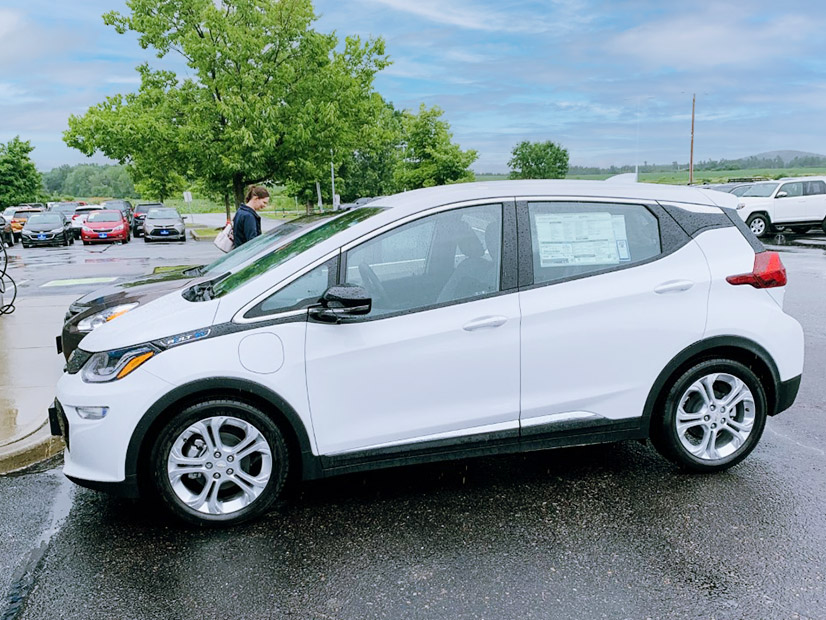
Vermont has released a draft comprehensive energy plan (CEP) for the state that aims to facilitate a clean energy transition in an equitable manner while keeping electric sector costs down.
Among the draft’s recommendations is to make all light-duty vehicles sold in the state zero-emission by 2035.
The plan would expand the state’s “aggressive” renewable energy target and adopt the state’s greenhouse gas reduction requirements, said TJ Poor, director of the Vermont Department of Public Service’s (DPS) Efficiency and Energy Resources Division.
“We also recognize that currently the burdens and the benefits of energy policy in the state have not been equitably distributed across the state or its people,” he said during a public stakeholder meeting for the CEP on Thursday.
The DPS must update the state’s energy plan every six years, and it will provisionally adopt the CEP in January after taking public comment on the draft by Dec. 20.
EV Sales
In the 2016 CEP, DPS set a goal of having 10% of vehicles in the state powered by electricity by 2025. By the end of 2015, there were slightly more than 1,000 electric vehicles registered in the state. The total in-state passenger vehicle registrations at the time was 550,000.
By 2017, passenger vehicle registrations had risen to 578,000, and by the end of 2020, just fewer than 4,000 were EVs, according to the Energy Action Network’s 2020/2021 Annual Progress Report for Vermont. And new passenger vehicle sales, the report said, averaged 38,500 annually between 2012 and 2020.
Of the vehicles sold in that period, a steadily increasing number were light passenger trucks or sport utility or crossover utility vehicles, reaching 85% in 2020. The state will face specific challenges in transitioning sales in those vehicle categories to zero-emission technologies in the near term.
All-electric SUVs and CUVs currently on the market range in price from $40,000 to $100,000, and light-duty trucks are yet to arrive. The draft CEP acknowledges that Vermont’s zero-emission vehicle goal is dependent on the national vehicle market, and the state should re-evaluate the EV sales goal regularly. It also suggests that Vermont can influence the national market by adopting California’s ZEV standards, which will help put pressure on vehicle manufacturers to produce more EVs.
In addition, Vermont’s state-level incentives for EVs are not available for models that cost more than $40,000.
“This presents a particular problem in rural areas of the state where [all-wheel drive] vehicles are a necessity,” the draft CEP said. “Higher incentive amounts will help accelerate the [plug-in EV] market, encouraging consumers to purchase EVs sooner than they might otherwise do so.”
Vermont also needs to incentivize development of a fast-charging network in advance of the passenger fleet’s ability to sustain it. The state is “a long way” from having the charging units needed to support electrification of the transportation sector, according to the draft CEP.
“To the extent funding is available, Vermont needs to substantially up its investment in [EV infrastructure],” the draft says. “This may need to include funding to operate fast-charging stations at unprofitable sites for a period of years until the market share of [plug-in EVs] increases enough to make these stations profitable.”
Other options in the draft plan for reducing transportation sector emissions include:
- establishing an incentive program for electric medium- and heavy-duty vehicles;
- determining the viability and cost-effectiveness of converting the state’s diesel transit bus fleet to electric;
- encouraging utilities to include utility load management for home and workplace EV charging; and
- encouraging utilities to offer rates that relieve fast-charging load from traditional demand charges.
Climate Plan Alignment
DPS staff worked closely with the Vermont Climate Council this year to ensure that the updated CEP would be in line with the council’s first Climate Action Plan (CAP). (See related story, Vt. Climate Council Adopts ‘Initial Climate Action Plan’.)
The council adopted its initial CAP on Dec. 1, but Poor said the CEP and CAP “are distinct plans.”
Both plans target GHG reduction requirements set by Vermont’s 2020 Global Warming Solutions Act. And while they shared energy sector analyses and public engagement during development, the CAP addresses energy and non-energy sector emissions.
The CEP and CAP also share recommendations to:
- adopt California’s Clean Cars II regulations;
- expand existing state weatherization programs (The CAP target is 90,000 homes by 2030, while the CEP target is 120,000 homes by 2030.);
- consider a clean heat standard;
- expand the state’s 75% renewable portfolio standard to 100% carbon-free power (The CAP target is “no later than” 2030; the CEP target is by 2032.); and
- continue to work with other jurisdictions on implementing the Transportation and Climate Initiative Program and consider participating in it.
Equity
For the first time, the CEP seeks to “root out and redress” inequities in the energy system that “continue to disproportionately impact many of Vermont’s communities,” Poor said.
A chapter on equity and injustice issues in the state leverages the work of the Vermont Climate Council’s Just Transitions Subcommittee in preparing the CAP.
The subcommittee’s work “really grounded the energy plan,” Poor said, noting that the draft CEP recommends that equity be centered in decision-making alongside cost and environmental issues.
Among the CEP’s recommendations for a just transition is a call for the DPS to develop a diversity, equity and inclusion strategy.

